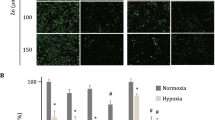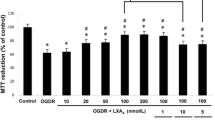Abstract
Pathological release of excess zinc ions and the resultant increase in intracellular zinc has been implicated in ischemic brain cell death, although the underlying mechanisms are not fully understood. Since zinc promotes the formation of the autophagic signal, reactive oxygen species (ROS), and increases autophagy, a known mechanism of cell death, we hypothesized that autophagy is involved in zinc-induced hypoxic cell death. To study this hypothesis, we determined the effect of zinc on autophagy and ROS generation in C8-D1A astrocytes subjected to hypoxia and rexoygenation (H/R), simulating ischemic stroke. C8-D1A astrocytes subjected to 3-h hypoxia and 18-h reoxygenation exhibited dramatically increased autophagy and astrocyte cell death in the presence of 100 μM zinc. Pharmacological inhibition of autophagy decreased zinc-potentiated H/R-induced cell death, while scavenging ROS reduced both autophagy and cell death caused by zinc-potentiated H/R. These data indicate that zinc-potentiated increases in ROS lead to over-exuberant autophagy and increased cell death in H/R-treated astrocytes. Furthermore, our elucidation of this novel mechanism indicates that modulation of autophagy, ROS, and zinc levels may be useful targets in decreasing brain damage during stroke.




Similar content being viewed by others
References
Galasso SL, Dyck RH (2007) The role of zinc in cerebral ischemia. Mol Med 13:380–387
Vogt K, Mellor J, Tong G, Nicoll R (2000) The actions of synaptically released zinc at hippocampal mossy fiber synapses. Neuron 26:187–196
Nguyen T, Hamby A, Massa SM (2005) Clioquinol down-regulates mutant huntingtin expression in vitro and mitigates pathology in a Huntington’s disease mouse model. Proc Natl Acad Sci U S A 102:11840–11845
Weiss JH, Sensi SL, Koh JY (2000) Zn (2+): a novel ionic mediator of neural injury in brain disease. Trends Pharmacol Sci 21:395–401
Frederickson CJ, Koh JY, Bush AI (2005) The neurobiology of zinc in health and disease. Nat Rev Neurosci 6:449–462
Cherny RA, Atwood CS, Xilinas ME, Gray DN, Jones WD et al (2001) Treatment with a copper-zinc chelator markedly and rapidly inhibits beta-amyloid accumulation in Alzheimer’s disease transgenic mice. Neuron 30:665–676
Kauppinen TM, Higashi Y, Suh SW, Escartin C, Nagasawa K et al (2008) Zinc triggers microglial activation. J Neurosci 28:5827–5835
Shuttleworth CW, Weiss JH (2011) Zinc: new clues to diverse roles in brain ischemia. Trends Pharmacol Sci 32:480–486
Liu D, Smith CL, Barone FC, Ellison JA, Lysko PG et al (1999) Astrocytic demise precedes delayed neuronal death in focal ischemic rat brain. Brain Res Mol Brain Res 68:29–41
Petito CK, Olarte JP, Roberts B, Nowak TS Jr, Pulsinelli WA (1998) Selective glial vulnerability following transient global ischemia in rat brain. J Neuropathol Exp Neurol 57:231–238
Ouyang YB, Voloboueva LA, Xu LJ, Giffard RG (2007) Selective dysfunction of hippocampal CA1 astrocytes contributes to delayed neuronal damage after transient forebrain ischemia. J Neurosci 27:4253–4260
Danilov CA, Fiskum G (2008) Hyperoxia promotes astrocyte cell death after oxygen and glucose deprivation. Glia 56:801–808
Pan R, Chen C, Liu WL, Liu KJ (2013) Zinc promotes the death of hypoxic astrocytes by upregulating hypoxia-induced hypoxia-inducible factor-1alpha expression via poly (ADP-ribose) polymerase-1. CNS Neurosci Ther 19:511–520
Bostanci Z, Alam S, Soybel DI, Kelleher SL (2013) Prolactin receptor attenuation induces zinc pool redistribution through ZnT2 and decreases invasion in MDA-MB-453 breast cancer cells. Exp Cell Res
Gustafsson AB, Gottlieb RA (2008) Recycle or die: the role of autophagy in cardioprotection. J Mol Cell Cardiol 44:654–661
Gurusamy N, Das DK (2009) Autophagy, redox signaling, and ventricular remodeling. Antioxid Redox Signal 11:1975–1988
Uchiyama Y, Koike M, Shibata M (2008) Autophagic neuron death in neonatal brain ischemia/hypoxia. Autophagy 4:404–408
Schweichel JU, Merker HJ (1973) The morphology of various types of cell death in prenatal tissues. Teratology 7:253–266
Qi ZF, Luo YM, Liu XR, Wang RL, Zhao HP, et al. (2012) AKT/GSK3beta-dependent autophagy contributes to the neuroprotection of limb remote ischemic postconditioning in the transient cerebral ischemic rat model. CNS Neurosci Ther 965–973
Cui D, Wang L, Qi A, Zhou Q, Zhang X et al (2012) Propofol prevents autophagic cell death following oxygen and glucose deprivation in PC12 cells and cerebral ischemia-reperfusion injury in rats. PLoS One 7:e35324
Cui DR, Wang L, Jiang W, Qi AH, Zhou QH et al (2013) Propofol prevents cerebral ischemia-triggered autophagy activation and cell death in the rat hippocampus through the NF-kappaB/p53 signaling pathway. Neuroscience 246:117–132
Kirkland RA, Adibhatla RM, Hatcher JF, Franklin JL (2002) Loss of cardiolipin and mitochondria during programmed neuronal death: evidence of a role for lipid peroxidation and autophagy. Neuroscience 115:587–602
Xue L, Fletcher GC, Tolkovsky AM (1999) Autophagy is activated by apoptotic signalling in sympathetic neurons: an alternative mechanism of death execution. Mol Cell Neurosci 14:180–198
Xu Y, Kim SO, Li Y, Han J (2006) Autophagy contributes to caspase-independent macrophage cell death. J Biol Chem 281:19179–19187
Scherz-Shouval R, Elazar Z (2007) ROS, mitochondria and the regulation of autophagy. Trends Cell Biol 17:422–427
Dineley KE, Richards LL, Votyakova TV, Reynolds IJ (2005) Zinc causes loss of membrane potential and elevates reactive oxygen species in rat brain mitochondria. Mitochondrion 5:55–65
Feigl G, Lehotai N, Molnar A, Ordog A, Rodriguez-Ruiz M, et al. (2014) Zinc induces distinct changes in the metabolism of reactive oxygen and nitrogen species (ROS and RNS) in the roots of two Brassica species with different sensitivity to zinc stress. Ann Bot
Ramirez DC, Mason RP (2005) Immuno-spin trapping: detection of protein-centered radicals. Curr Protoc Toxicol Chapter 17: Unit 17 17.
Towner RA, Smith N, Saunders D, Henderson M, Downum K et al (2012) In vivo imaging of immuno-spin trapped radicals with molecular magnetic resonance imaging in a diabetic mouse model. Diabetes 61:2405–2413
Detweiler CD, Deterding LJ, Tomer KB, Chignell CF, Germolec D et al (2002) Immunological identification of the heart myoglobin radical formed by hydrogen peroxide. Free Radic Biol Med 33:364–369
Schaller B (2005) Prospects for the future: the role of free radicals in the treatment of stroke. Free Radic Biol Med 38:411–425
Coyle JT, Puttfarcken P (1993) Oxidative stress, glutamate, and neurodegenerative disorders. Science 262:689–695
Liuzzi JP, Yoo C (2013) Role of zinc in the regulation of autophagy during ethanol exposure in human hepatoma cells. Biol Trace Elem Res 156:350–356
Cho KS, Yoon YH, Choi JA, Lee SJ, Koh JY (2012) Induction of autophagy and cell death by tamoxifen in cultured retinal pigment epithelial and photoreceptor cells. Invest Ophthalmol Vis Sci 53:5344–5353
Kim KW, Speirs CK, Jung DK, Lu B (2011) The zinc ionophore PCI-5002 radiosensitizes non-small cell lung cancer cells by enhancing autophagic cell death. J Thorac Oncol Off Publ Int Assoc Study Lung Cancer 6:1542–1552
Hwang JJ, Kim HN, Kim J, Cho DH, Kim MJ et al (2010) Zinc (II) ion mediates tamoxifen-induced autophagy and cell death in MCF-7 breast cancer cell line. Biometals Int J Role Met Ions Biol Biochemistry Med 23:997–1013
Lee SJ, Cho KS, Koh JY (2009) Oxidative injury triggers autophagy in astrocytes: the role of endogenous zinc. Glia 57:1351–1361
Park MH, Lee SJ, Byun HR, Kim Y, Oh YJ et al (2011) Clioquinol induces autophagy in cultured astrocytes and neurons by acting as a zinc ionophore. Neurobiol Dis 42:242–251
Zhang X, Yan H, Yuan Y, Gao J, Shen Z, et al (2013) Cerebral ischemia–reperfusion-induced autophagy protects against neuronal injury by mitochondrial clearance. Autophagy 9
He S, Wang C, Dong H, Xia F, Zhou H et al (2012) Immune-related GTPase M (IRGM1) regulates neuronal autophagy in a mouse model of stroke. Autophagy 8:1621–1627
Pan R (2013) Autophagy in cerebral ischemia: therapist or killer. Biomolecular Res Ther 2:e111
Domercq M, Mato S, Soria FN, Sanchez-gomez MV, Alberdi E et al (2013) Zn2+ − induced ERK activation mediates PARP-1-dependent ischemic-reoxygenation damage to oligodendrocytes. Glia 61:383–393
Aguilar-Alonso P, Martinez-Fong D, Pazos-Salazar NG, Brambila E, Gonzalez-Barrios JA et al (2008) The increase in zinc levels and upregulation of zinc transporters are mediated by nitric oxide in the cerebral cortex after transient ischemia in the rat. Brain Res 1200:89–98
Nicholls DG, Budd SL (2000) Mitochondria and neuronal survival. Physiol Rev 80:315–360
Federico A, Cardaioli E, Pozzo PD, Formichi P, Gallus GN, et al (2012) Mitochondria, oxidative stress and neurodegeneration. J Neurol Sci
Acknowledgments
This work was supported in part by grants from NIH (P20RR15636, P30GM103400, and R01AG031725).
Competing Interests
The authors declare that they have no competing interests.
Author information
Authors and Affiliations
Corresponding author
Rights and permissions
About this article
Cite this article
Pan, R., Timmins, G.S., Liu, W. et al. Autophagy Mediates Astrocyte Death During Zinc-Potentiated Ischemia–Reperfusion Injury. Biol Trace Elem Res 166, 89–95 (2015). https://doi.org/10.1007/s12011-015-0287-6
Received:
Accepted:
Published:
Issue Date:
DOI: https://doi.org/10.1007/s12011-015-0287-6




